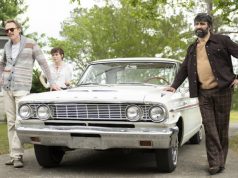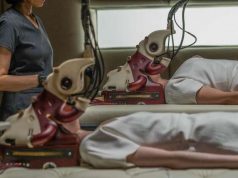One of the perks of the Internet is that you can find out embarrassing information about otherwise-respectable people. For example, Chuck Workman, who wrote and directed the thorough and professional Beatnik documentary “The Source,” also wrote and directed the 1985 comedy “Stoogemania.”
To be fair, he also did 1991’s “Superstar: The Life and Times of Andy Warhol,” which was every bit as thorough — and, in its way, perhaps TOO complete to appeal to the average viewer — as “The Source.”
Allen Ginsberg and Jack Kerouac met in New York in 1944. They later acquired William S. Burroughs as part of their enclave of dissatisfied young people, and eventually all three wrote their seminal works: Kerouac’s “On the Road,” then Ginsberg’s “Howl,” then Burroughs’s “The Naked Lunch.” These were the leaders of the “Beat” generation, a term given several possible origins in the film, which interviews pretty much every living member of the Beat movement, and includes footage of the three leaders filmed before their deaths. “Beat” had to do with the rhythm of the drums, it had to do with being tired and burned-out (“Aw, man, I’m beat”), it meant pretty much whatever you wanted it to.
The point was, these were disillusioned young men. “The Source” paints them as only mildly angry, rebels with a cause, but a cause that was not well-defined. Where the Hippies (direct descendants of the Beats) had specific things like Vietnam and the various assassinations to stir them up, not to mention the support of practically every successful rock group of the late ’60s, the Beatniks had complaints that were more vague. (This at least partially explains why, as “The Source” points out, the Beatniks were largely ignored until the 1960s.)
The 1950s, the Beatniks maintained, were not the idyllic, “Leave It to Beaver” times that everyone seemed to think they were. There was the Korean War and the McCarthy hearings (both of which came and went in a relatively short period of time, in the grand scheme of things), and — most galling to these decidedly individualistic college students — rampant conformity spreading through America like a virus.
In a way, the Beatniks’ cause was more noble than the Hippies’. The Hippies were fighting tangible “evils.” People may not have agreed with them, but at least they could see their point. Furthermore, they wanted peace and love — hardly a controversial position.
The Beatniks were fighting things that people wouldn’t even acknowledge the existence of, let alone take a stand on: the paranoid aftermath of McCarthy, the glossing-over of the negative elements of society, that darned “conform or be a freak” mentality.
The Beatniks were clearly more literate and intelligent in their creative outlets than the Hippies, too. (Compare the absurdly banned “Howl” — ” I saw the best minds of my generation destroyed by madness, starving hysterical naked, dragging themselves through the negro streets at dawn looking for an angry fix” — with anything Jim Morrison ever wrote, for example.)
“The Source” benefits from fine readings by Johnny Depp, Jon Turturro and Dennis Hopper, vividly re-creating the passion and furor of the original Beats’ words.
Where the documentary suffers is that, while it tells you the entire story, it loses steam about half-way through. Unless you’re already interested in the subject matter, “The Source” is unlikely to interest you beyond the first 45 minutes. Furthermore, with the Beatniks evolving into Hippies, which evolved into whatever they evolved into, it’s a story that lacks an ending.
Nonetheless, it’s hard not to gain an appreciation for a movement that is largely overlooked now, and that influenced pop culture more than many of us realize.
B (; )





